Despite every effort at eradication, this bacterial disease has turned up everywhere potatoes are grown. It's got some kind of last ditch survival mechanism that we don't understand or have discovered. Perhaps this BRR bacterium can live in exotic potato cultivars and never cause disease. A few years back in the 1980's, infected clones of Urgenta, Bel Rus, and Teton with BRR bacteria but after growing on these clones for a few years, the BRR bacteria disappeared in these three cultivars. Had the bacteria vanished or were they present at a level that made them undetectable to the detection technology at that time.
We're not alone in Canada in combating BRR since in the last few years this disease has become widespread in Europe after it was thought that this disease was virtually eradicated. In 2003, BRR has been reported from 1 farm in Wales and 2 farms in England. It is suspected that at least two sources of BRR infected potatoes were introduced into the UK where some 300,000 to 400,000 acres are grown annually. The Welsh BRR infection originated from tubers supplied by a Dutch grower in the Netherlands. The original source of BRR in England has yet to be traced. In recent years, BRR has caused problems in France, Germany, the Netherlands and Denmark.
How bacterial ring rot has reappeared in seed potatoes remains a mystery. The litigious disease thought to have been eliminated from the United Kingdom a very long time ago has now (2002) appeared in at least 4 farms in England and Wales.
What to look for?

Photo: Evans | The Irish Orchid
Potato flowers are typically white, ping or purple | 
Photo: Evans | Alberta seed potato production now second only to PEI |

Photo: Evans | Bacterial Ring Rot (BRR) Research Plots. The late John Stenrue, BRR inspector, was reputed to spot a ring rot infestation for 100 paces. | 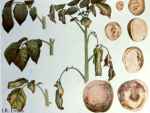
Photo: Evans | Old Federal poster depicting BRR the scourge of the potato industry at the early part of the 20th century |
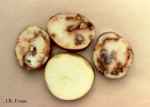
Photo: Evans | BRR on highly or susceptible cultivars generally causes complete tuber rotting soon after harvest. | 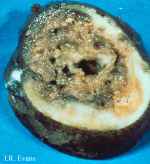
Photo: Evans | BRR infection causes total tuber rot in susceptible potato cultivars sometimes prior to harvest |
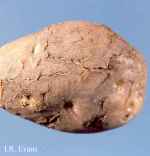
Photo: Evans | BRR in Russet Burbank may have a few slight cracks. This cultivar shows a good degree of resistance to BRR | 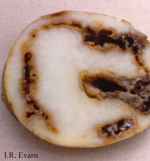
Photo: Evans | Not the ring pattern of BRR - following the major vascular tissue inside the potato. In some cultivars the BRR infection may not proceed further in storage. |

Photo: Evans | BRR cause major yield loses in very susceptible cultivars even before harvest. | 
Photo: Evans | BRR trial with very many different potato cultivars from total resistance to extreme susceptibility. |

Photo: Evans | Norchip - very highly susceptible to BRR. | 
Photo: Evans | Russet Burbank - somewhat resistant to BRR and not that easily infected. |
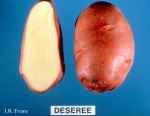
Photo: Evans | Deseree - highly resistant to BRR. | 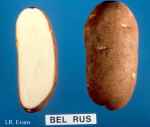
Photo: Evans | Bel Rus - very resistant to BRR. |
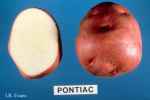
Photo: Evans | Pontiac - highly susceptible to BRR. | 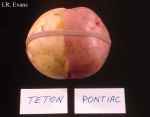
Photo: Evans | An elastic band binding healthy Pontiac potato halves to a symptomless Teton, Bel Rus and Urgenta potato halves. The Teton, Bel Rus and Urgent arose from parent tubers that had been deliberately inoculated with an undiluted culture of BRR the previous year. |

Photo: Evans | Ten tubers each of Teton, Bel Rus and Urgent all resistant to BRR were bound to healthy Pontiac potato halves and planted out in replicate trials with lots of checks | 
Photo: Evans | Around 70% of the elastic bound Pontiacs bound to the Bel Rus, Teton and Urgenta halves showed up with BRR infections after being bound to the symptomless potato cultivars. Note the wilted Pontiac stem in the centre of this experiment.1
. |

Photo: Evans | In order for the BRR bacteria to move from the seed piece to new tubers, it must first pass from the infected tuber into the transport system of the stem.
| 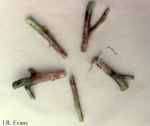
Photo: Evans | In resistant cultivars, the BRR bacteria may not enter if any of the new tubers in sufficient quantity to cause an obvious rot.
Stem pieces cut next to the old tuber are the best possible place to find the BRR bacteria even in resistant cultivars seed.
. |
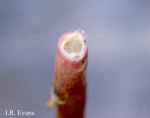
Photo: Evans | Cut stem end of a potato vine. | 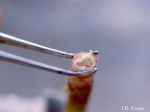
Photo: Evans | Gentle squeezing may produce a milky fluid - obvious signs of the BRR bacteria. |

Photo: Evans | In low levels of BRR bacterium in the stem piece a pair of needle-nosed forceps was used to squeeze the stem. | 
Photo: Evans | The old technique was to demonstrate the presence of gram positive staining bacteria, a method now superseded by modern technology. |
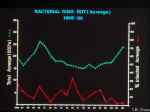
Photo: Evans | From the mid-eighties to the present time BRR was thought to be eliminated from Alberta seed potato stocks. | 
Photo: Evans | Elimination of BRR coincided with a steady and continuing rise in the export seed potato sales for distribution in the U.S. |

Photo: Evans | Rosette stage; mid to late August
Typical of Russet Burbank which is somewhat resistant to this disease. | 
Photo: Evans | Bacterial Ring Rot symptoms in Teton. Tuber disease symptoms are rarely visible in such resistant varieties, but the bacteria has been shown to be present in the absence of any disease symptoms. |

Photo: Evans | One stem totally wilted. Late August early September typical of Russet Burbank infection when only some of the tubers may show obvious BRR disease. | 
Photo: Evans | Mild internal symptoms of Bacterial Ring Rot; Typical of a resistant Russet Burbank infection following harvest. |

Photo: Evans | Severe internal symptoms of Bacterial Ring Rot; Typical of very susceptible cultivars e.g. Norland which can rot prior to harvest. | 
Photo: Evans | Some potato cultivars e.g. Teton, Deseree and Urgent are very resistance to Bacterial Ring Rot, no symptoms may ever show even if the BRR bacteria are present and readily recovered. |

Photo: Letal | Old method of Bacterial Ring Rot diagnosis; gram stain showing BRR bacteria. An old but reliable method abandoned in 1990. |  |  |